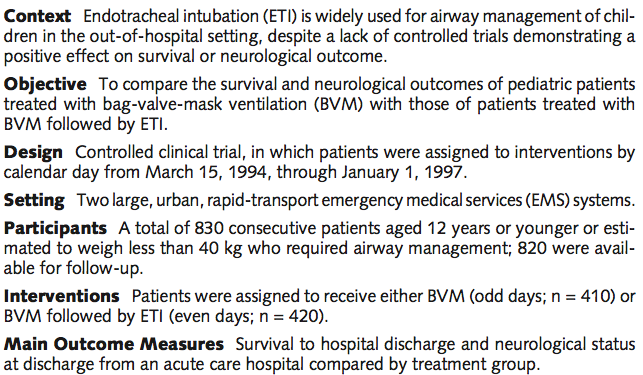7.4 CIs for one proportion
Endotracheal intubation (ETI) is a method for maintaining an open airway or as a method for administering certain drugs for ill patients. ETI is widely used for airway management of children in the out-of-hospital setting, but for many years little evidence was available on the effect of using ETI. The BVM ('ball valve mask') method is also used.
Gausche et al. (2000) examined the use of ETI for airway management of children in the out-of-hospital setting.

FIGURE 7.1: Part of the Abstract from Gausche et al. (2000).
- For the BVM sample, \(123\) out of the \(404\) patients survived. For those receiving BVM, compute the sample odds of a patient who survived.
- For the BVM sample, \(123\) out of the \(404\) patients survived. For those receiving BVM, compute an estimate of the population proportion of patients who survive.
- Explain the difference between the meaning of the two above calculations.
- In another sample of \(404\) patients who received the BVM treatment, would we expect to find exactly \(123\) surviving? Why or why not?
- Compute the standard error of \(\hat{p}\), which indicates the sampling variability in the estimate of \(p\). Explain what is meant by the term 'sampling variation' in this context.
- Every time a new sample is chosen, the sample will likely yield a different value for \(\hat{p}\). Sketch the distribution that shows how much the value of \(\hat{p}\) is likely to change from one sample to the next.
- Compute an approximate \(95\)% confidence interval for the population proportion based on the sample proportion.
- Write a sentence communicating this confidence interval.
- If the researchers wished to estimate the true survival proportion to within give-or-take \(0.01\) with \(95\)% confidence, would the sample size need to be larger or smaller?
- Confirm that the conditions necessary for this calculation to be statistically valid are met.
References
Gausche M, Lewis RJ, Stratton SJ, Haynes BE, Gunter CS, Goodrich SM, et al. Effect of out-of-hospital pediatric endotracheal intubation on survival and neurological outcome: A controlled clinical trial. Journal of the American Medical Association. 2000;283(6):783–90.